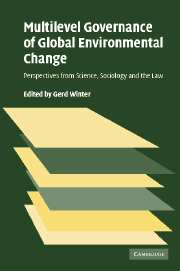 Multilevel Governance of Global Environmental Change
Multilevel Governance of Global Environmental Change Book contents
- Frontmatter
- PREFACE
- Contents
- List of figures
- List of tables
- Notes on contributors
- List of abbreviations
- 1 Introduction
- PART I Earth system analysis
- PART II Society and institutions of global; environmental change
- PART III Self-regulation of industry and the law
- PART IV The potential of the state
- PART V The potential of world regions
- PART VI Formation and implementation of international regimes
- PART VII Improving the instruments of global governance
- PART VIII Fundamental concepts of institutionalising common concern
- 21 Global environmental change and the nation state: sovereignty bounded?
- 22 Whose environment? Concepts of commonality in international environmental law
- 23 Globalising environmental liability: the interplay of national and international law
- 24 The legal nature of environmental principles in international, EU, and exemplary national law
- Index
23 - Globalising environmental liability: the interplay of national and international law
Published online by Cambridge University Press: 04 May 2010
- Frontmatter
- PREFACE
- Contents
- List of figures
- List of tables
- Notes on contributors
- List of abbreviations
- 1 Introduction
- PART I Earth system analysis
- PART II Society and institutions of global; environmental change
- PART III Self-regulation of industry and the law
- PART IV The potential of the state
- PART V The potential of world regions
- PART VI Formation and implementation of international regimes
- PART VII Improving the instruments of global governance
- PART VIII Fundamental concepts of institutionalising common concern
- 21 Global environmental change and the nation state: sovereignty bounded?
- 22 Whose environment? Concepts of commonality in international environmental law
- 23 Globalising environmental liability: the interplay of national and international law
- 24 The legal nature of environmental principles in international, EU, and exemplary national law
- Index
Summary
Introduction
Liability for loss or damage is an elementary feature of a legal system; it remains an important part of most systems of environmental law even when supplemented or in part superseded by regulatory regimes, risk avoidance procedures, and criminal penalties. In international law, liability for transboundary damage, based on analogies going back to Roman law, is one of the oldest concepts available in interstate disputes. An international arbitral award, delivered in 1938 and 1941, is the seminal judicial contribution to the international law on the subject. Since then, however, there has been only limited judicial elaboration at an international level, and the precise character of this elementary concept remains unsettled. On the most widely held view, the responsibility of states for transboundary damage depends principally on objective fault, i.e. a failure to act with due care or diligence, or a breach of treaty, or the commission of a prohibited act. If states can be held more generally responsible without showing fault, the examples remain at best exceptional and questionable. The principle of state responsibility for transboundary damage is not in doubt, however. It has been incorporated in treaties, recognised in the law of state responsibility, and invoked by the UN Security Council.
In the 1960s and 1970s, a number of civil liability and compensation Conventions were negotiated in order to address two of the most hazardous and significant transboundary risks: oil pollution at sea and nuclear accidents. They represent an alternative approach to liability for transboundary damage.
- Type
- Chapter
- Information
- Multilevel Governance of Global Environmental ChangePerspectives from Science, Sociology and the Law, pp. 559 - 586Publisher: Cambridge University PressPrint publication year: 2006
- 2
- Cited by


